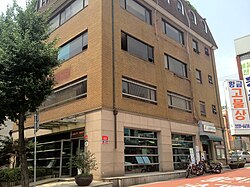Sindang-dong (Korean: 신당동) is a dong, neighbourhood of Jung-gu in Seoul, South Korea.[2]
Sindang-dong | |
|---|---|
| Korean transcription(s) | |
| • Hangul | 신당동 |
| • Hanja | 新堂洞 |
| • Revised Romanization | Sindang dong |
| • McCune–Reischauer | Sindang tong |
 Sindang-dong Resident Office | |
 | |
| Country | South Korea |
| Area | |
| • Total | 0.55 km2 (0.21 sq mi) |
| Population (2013[1]) | |
| • Total | 7,712 |
| • Density | 14,000/km2 (36,000/sq mi) |
Name origin edit
The name "Sin-dang-dong" came from an ancient village with a shrine for worshipping gods, which was connected to the place of worship. "Heung-in-dong," situated west of Dasan Road, got its name from "Heung-in Ji-mun" in Dongdaemun. As for "Mu-hak-dong," found southwest of the Sin-dang-dong intersection, it derived its name from Mt. Mu-hak-bong (92m) south of the Korea Road Traffic Authority, with a legend that a crane descended and danced on the mountain.
Attractions edit
The neighbourhood is near Sindang Station and is approximately two blocks from exit 8. It is a popular shopping area with a variety of food markets, and eateries that specialise in Korean snacks such as Ddeokbokki.[3] It is known to Koreans for its Ddeokbokki Town.[citation needed]
A former home of South Korean president Park Chung Hee is located in the neighborhood and is open to public visitation.[4]
Transportation edit
- Sindang Station of and of
- Cheonggu Station of and of
See also edit
References edit
- ^ "월별인구통계 | 중구통계". Archived from the original on 2013-09-28. Retrieved 2013-09-15.
- ^ "신당동 (Sindang-dong 新堂洞)" (in Korean). Archived from the original on 2006-02-22. Retrieved 2008-05-09.
- ^ "Visit Seoul: Chungmu Art Hall" Archived 2012-11-08 at the Wayback Machine Seoul Tourism Organization. Retrieved 2012-04-03
- ^ "Park Chung-hee's House in Sindang-dong, Seoul". Cultural Heritage Administration. Retrieved 2023-08-21.
- "Chronicle of Beopjeong-dong and Haengjeong-dong" (in Korean). Guro-gu Official website.
- "Mapo Information". The chart of Beopjeong-dong assigned by Haengjeong-dong (행정동별 관할 법정동 일람표) (in Korean). Mapo-gu Official website.
External links edit
- Jung-gu Official site in English
- (in Korean) Jung-gu Official site[permanent dead link]
- (in Korean) Jung-gu Tour Guide from the Official site
- (in Korean) Status quo of Jung-gu
- (in Korean) Resident offices and maps of Jung-gu[dead link]
- (in Korean) Sindang 1-dong resident office website
35°48′N 128°26′E / 35.800°N 128.433°E